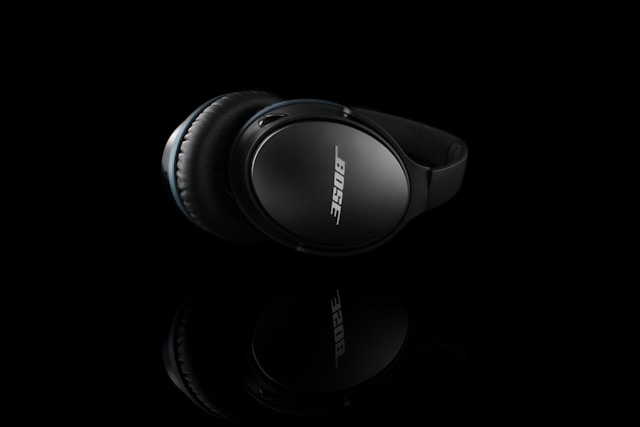Before we dive deep into the SWOT analysis, let’s get the business overview of Bose. Bose Corporation is a renowned American company specializing in designing, developing, and selling audio equipment. Founded in 1964 by Dr. Amar G. Bose, the company has built a reputation for high-quality sound products, innovative technologies, and a commitment to research and development in acoustics. Bose is headquartered in Framingham, Massachusetts, and operates globally.
Core Business Areas:
- Consumer Electronics: Bose is best known for its wide range of consumer audio products, including noise-canceling headphones, wireless speakers, home theater systems, and portable audio devices. These products are designed to deliver superior sound quality and user experience.
- Professional Audio Systems: Bose also provides professional sound solutions for venues such as theaters, churches, stadiums, and restaurants. These include loudspeakers, amplifiers, and sound management systems for large-scale audio requirements.
- Automotive Sound Systems: Bose partners with various automobile manufacturers to design and integrate high-quality sound systems into vehicles. These automotive sound systems are tailored to the acoustics of each car model, enhancing the in-car audio experience.
- Noise Reduction Technology: Bose is a pioneer in noise-canceling technology, a feature that has become synonymous with the brand. This technology is used in headphones and earphones, offering users an immersive listening experience by effectively blocking out external noise.
Bose Corporation generated annual sales revenue of three billion U.S. dollars in the fiscal year 2023. There was a drop in sales compared to the two years before.
Here is the SWOT analysis for Bose
A SWOT analysis is a strategic planning tool used to evaluate the Strengths, Weaknesses, Opportunities, and Threats of a business, project, or individual. It involves identifying the internal and external factors that can affect a venture’s success or failure and analyzing them to develop a strategic plan. In this article, we do a SWOT Analysis of Bose.
SWOT Analysis: Meaning, Importance, and Examples
Strengths
- Brand Reputation: Bose has built a strong brand reputation for quality, innovation, and reliability in the audio equipment market. Its brand is synonymous with high-quality sound and advanced acoustic engineering, appealing to both audiophiles and general consumers.
- Innovative Products: Bose is known for its commitment to research and development, leading to innovative products like noise-canceling headphones, Wave music systems, and SoundLink speakers. This focus on innovation has allowed Bose to stay at the forefront of audio technology.
- Sound Quality: The company’s emphasis on superior sound quality, driven by proprietary technologies and acoustic design, distinguishes its products in a crowded market. Bose’s ability to deliver clear, rich sound has earned it a loyal customer base.
- Diverse Product Range: Bose offers a wide range of audio products, including headphones, speakers, home theater systems, and automotive sound systems, catering to various consumer needs and preferences.
- Global Presence: Bose has a robust global presence, with products available in numerous countries through a mix of Bose-owned stores, authorized retailers, and online platforms. This comprehensive distribution network helps Bose reach a broad customer base.
- Customer Experience: Bose places a strong emphasis on customer experience, offering personalized services, extensive warranties, and responsive customer support. This commitment to customer satisfaction has helped build brand loyalty.
- Market Positioning: Bose effectively positions its products as premium offerings in the audio market. This positioning and the brand’s reputation for quality allow Bose to command higher price points and maintain profitability.
- Strategic Partnerships: Bose has formed strategic partnerships in various sectors, including automotive and aviation, integrating its sound systems into luxury cars and airline entertainment systems, further enhancing its brand visibility and reach.
Weaknesses
- Premium Pricing: Bose’s products are often priced higher than many of its competitors, limiting its market to consumers willing and able to pay a premium for audio equipment. This pricing strategy may exclude a significant portion of the market looking for more affordable options.
- Limited Product Range: Compared to some of its competitors, Bose has a relatively focused product line, primarily centered around audio equipment like headphones, speakers, and home audio systems. This limited diversification could be a weakness if consumer preferences shift away from these categories.
- Perception of Over-Emphasis on Branding: While Bose is known for quality, some critics argue that part of what consumers pay for is the brand name itself, suggesting that similar quality could be available at lower prices from other brands. This perception could deter some price-sensitive customers.
- Competition in the Wireless and Smart Speaker Market: The audio market has shifted towards wireless and smart speakers, with many tech companies entering the space. Bose faces stiff competition from brands that may offer more features, such as voice control integration with popular virtual assistants, at competitive prices.
- Dependence on Retail and Third-Party Distributors: Bose has traditionally relied heavily on third-party retailers and its own branded stores to sell its products. The shift towards online shopping, accelerated by the COVID-19 pandemic, could pose a challenge if Bose does not strengthen its direct-to-consumer online sales channel.
- Innovation Pace: The audio technology sector is rapidly evolving, with continuous advancements in features like noise cancellation, sound quality, and integration with smart home ecosystems. Keeping pace with innovation and consumer expectations in this fast-changing environment is a challenge.
- Market Saturation: The audio equipment market is highly saturated, with numerous established brands and new entrants offering a wide range of products. Standing out in this crowded market requires continuous innovation and marketing efforts.
Opportunities
- Expansion into Emerging Markets: With the global increase in disposable income, especially in emerging markets, Bose can expand its footprint and increase market share by targeting these new customer bases with tailored marketing and product offerings.
- Product Diversification: Diversifying its product lineup to include more categories such as wearable audio devices, smart home speakers, and audio solutions for the healthcare and automotive industries, can open new revenue streams and reduce dependence on traditional product lines.
- Technological Innovation: Investing in research and development to introduce cutting-edge audio technologies, such as advanced noise cancellation, 3D audio, and AI-driven personalization, can reinforce Bose’s position as an industry leader in innovation.
- Partnerships and Collaborations: Strategic partnerships with tech companies, music industry players, and automotive manufacturers can enhance Bose’s brand visibility and integration into various ecosystems, from home entertainment to vehicles.
- Sustainability Initiatives: Emphasizing sustainability in product design, packaging, and corporate operations can appeal to environmentally conscious consumers and contribute positively to Bose’s brand image and corporate social responsibility.
- Enhanced Digital Presence: Strengthening its e-commerce platform and digital marketing strategies can improve customer engagement, personalize the shopping experience, and drive online sales, which is particularly important in a post-pandemic retail landscape.
- Smart Home Integration: With the growing demand for smart home devices, Bose has the opportunity further to integrate its products with popular home automation systems, making them a central part of the connected home experience.
- Health and Wellness Market: Exploring the health and wellness sector with products incorporating audio for therapeutic purposes, like noise-masking sleepbuds or audio-based meditation and wellness apps, can tap into a growing consumer interest in health and well-being.
Threats
- Intense Competition: The audio equipment market is highly competitive, with numerous established brands and new entrants offering innovative products, often at lower price points. Companies like Sony and Sennheiser and newer players like Apple with their AirPods pose significant competition.
- Technological Disruption: Rapid technological advancements can render existing products obsolete. Bose needs to continually innovate to stay ahead, as emerging technologies in audio and connectivity could disrupt the market.
- Counterfeit Products: The market is flooded with counterfeit and lower-quality imitations of popular Bose products, which can erode brand trust and loyalty and impact sales.
- Economic Downturns: Global economic instability or downturns can reduce consumer spending on non-essential luxury items like high-end audio equipment, affecting Bose’s sales and profitability.
- Changes in Consumer Preferences: Consumer preferences in the audio market constantly evolve, with a growing demand for integrated smart features and wireless capabilities. Failure to align product offerings with these trends could result in lost market share.
- Supply Chain Disruptions: Bose, like many global manufacturers, relies on complex international supply chains. Disruptions due to geopolitical tensions, trade disputes, or pandemics can impact production, increase costs, and delay product deliveries.
- Regulatory Challenges: Changes in international trade policies, tariffs, and regulatory standards for electronics can pose operational and financial challenges, affecting market access and product pricing.
- Dependence on Third-Party Retailers: Bose’s reliance on third-party retailers and distributors for a significant portion of its sales exposes it to risks associated with changes in retailer strategies, financial health, and market presence.









